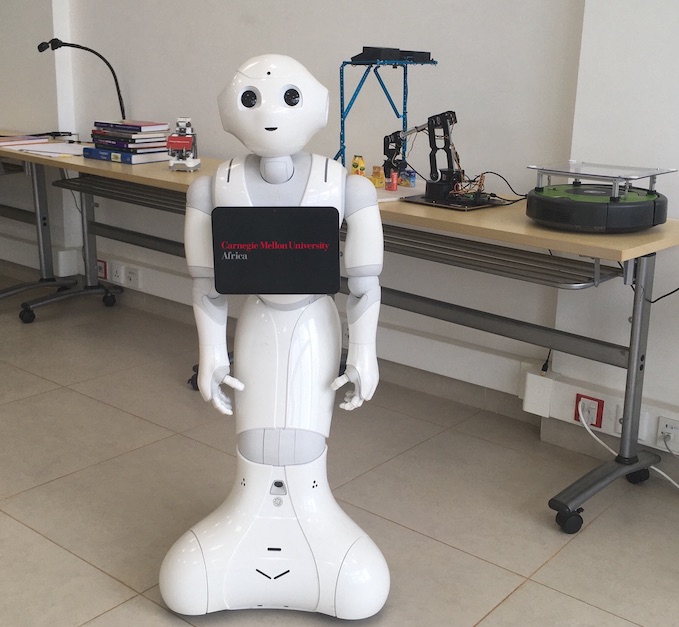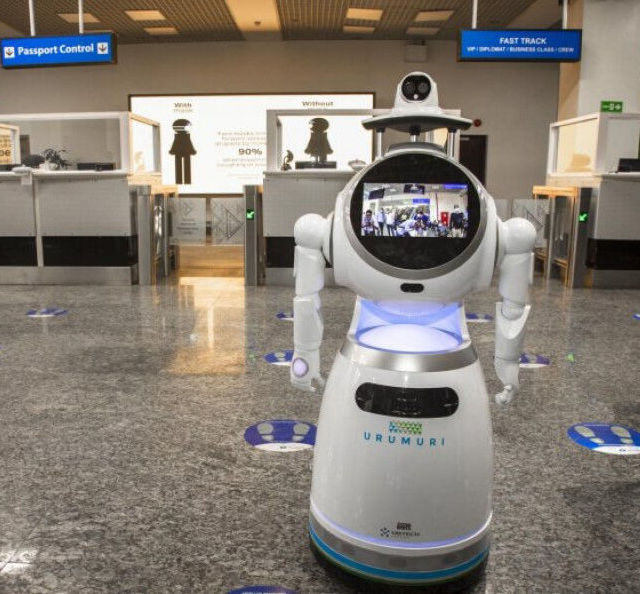


(Left) A Pepper social robot in the Carnegie Mellon University Africa Robotics Lab in Rwanda, and
(Right) an Ubtech CRUZR service robot deployed by ZoraBots Africa Ltd. to check the temperature of travellers arriving at Kigali International Airport, Rwanda.
Course Description | Learning Objectives | Outcomes | Lecture Notes | Course Textbook | Recommended Reading | Resources
Course Description
In the future, robots will increasingly become a part of our daily lives and we will interact with them and they with us: in our airports, hospitals, offices, shops, and homes, as well as in our factories. Human-robot interaction (HRI) is concerned with the problem of making this interaction natural and effective. It is a multidisciplinary field and includes elements of engineering, computer science, robotics, psychology, sociology, and design. This course explores the way in which these disciplines contribute to the field of HRI and it will give students the foundation needed to develop robot systems that can interact effectively with humans. The course is delivered through a mix of teaching, reading, and in-class discussion. Student progress is assessed by a series of multiple choice tests and written individual & group assignments. There are no prerequisites for taking this course although it would be an advantage to have taken 18-799-K Artificial Cognitive Systems.
Learning Objectives
Students will be introduced to the different disciplines that contribute to an understanding interaction and the role they play in developing a successful HRI system. The will learn about the different components of a robot and the software control of a robot. They will learn what is required for effective interaction between humans and robots. They will be introduced to the different interaction modalities – spatial, non-verbal, verbal, and emotional – and how they relate to robotics. Students will be learn about the problems that still exist in the field and how to assess possible solutions to these problems. They will also learn about current and future use of robots in society, in a variety of applications.
Outcomes
After completing this course, students will be able to do the following.
Lecture Notes
Module 1: The Nature of Human-Robot Interaction
Module 2: The Components, Structure, and Operation of a robot
Module 3: Design
Module 4: Interaction
Module 5: Emotion
Module 6: Applications
Module 7: Robots in Society
Recommended Reading
Mataric, M. The Robotics Primer , MIT Press, 2007.
Lecture 1. Overview of Human-Robot Interaction.
Lecture 1. Robot hardware, sensors.
Lecture 2. Actuators, software, limitations of robotics for HRI.
Lecture 1. Physical design and anthropomorphism.
Lecture 2. Design methods, prototyping tools, culture in HRI design, & human-robot symbiosis.
Lecture 1. Spatial interaction.
Lecture 2. Nonverbal interaction.
Lecture 3. Human-human verbal interaction; speech recognition.
Lecture 4. Dialogue management; speech production.
Lecture 1. The roles of emotions in interaction.
Lecture 2. Emotions for robots.
Lecture 1. It's a tough market & robots for X.
Lecture 2. Robots for X & problems with robot application.
Lecture 1. Robots in the popular media; ethics in HRI.
Lecture 1. The future of HRI.